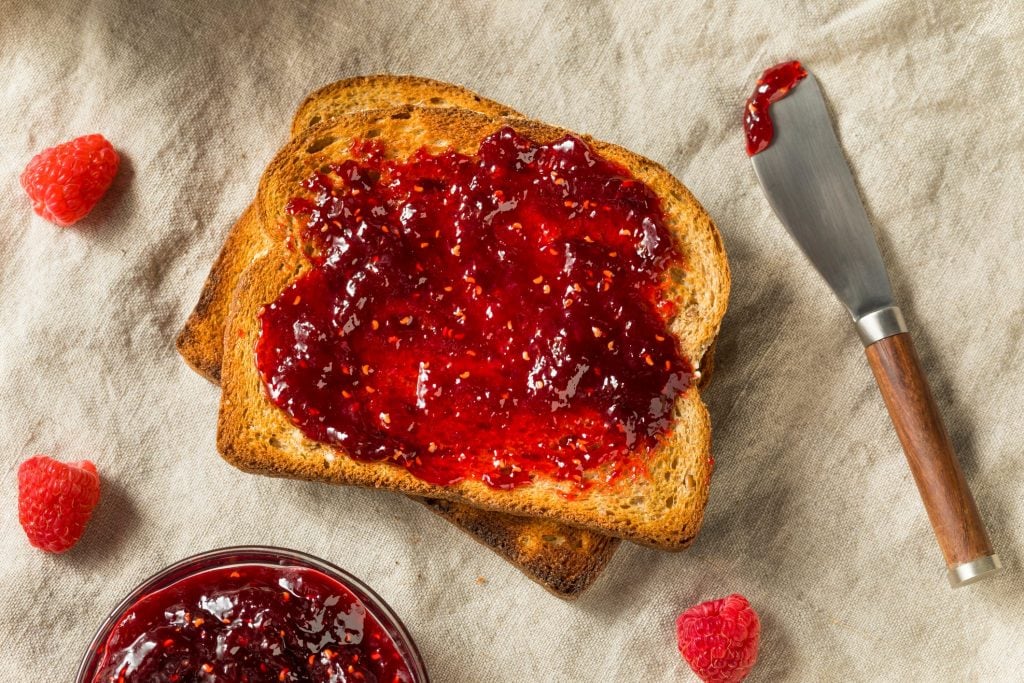- Jelly, jam, and preserves are all types of fruit spreads made from heating pectin, sugar, and acid.
- Jelly is made from fruit juice and has a firmer gel and a smooth texture.
- Jams and preserves are made from whole fruits, resulting in a crushed texture.
There's an age-old question: What is the difference between jam and jelly?
All fruit spreads like jam and jelly are similar in that they're gelled by heating pectin, sugar, and acid. Pectin is a naturally occurring compound in the fruit, but jam or jelly makers will occasionally add more pectin (and sometimes acid) to achieve their ideal consistency.
When it comes to their differences, however, jam, jelly, and other fruit spreads vary in their texture and ingredients.
Elizabeth L. Andress, Ph.D. — former director of the National Center for Home Food Preservation, and author of the "Complete Guide to Home Canning" for the USDA — helps break down the key differences between each.
What is jelly?

The key distinguishing factor in jelly is that it's made with fruit juice, not fruit pulp. This gives it a distinct firmness and a homogeneous consistency.
The fruit juice is cooked down with sugar to release pectin, a naturally occurring thickening compound found in fruit and its juices. Some fruits contain more pectin than others, so jelly makers may add additional pectin to get the texture they're looking for.
The consistency of jelly is quite firm, smooth, and clear — it holds its shape more than a jam or fruit preserve.
If jelly is being sold in the United States, it needs to meet requirements to be labeled as jelly. "If it doesn't have a certain amount of sugar in it, then they can't use the term 'jelly.' If you get into low sugar or no sugar added jelly, you're more likely to see a commercial product called a 'spread,'" Andress says. These regulations also control the type of fruit juices permitted, how the fruit juice is collected, the type of sugar, and any additional ingredients like added pectin or spices.
Jellies, because of their consistency, work best as a spread on items like toast, bagels, scones, or croissants.
What is jam?

Jam is looser and chunkier compared to jelly. Instead of fruit juice, the spread is made with whole, ripe fruit and sugar. The fruit is chopped or mashed and cooked down with the sugar, resulting in a spread that has small pieces of fruit throughout. Depending on the jam maker's preferences, added pectin or acid can be used to create the desired consistency.
Jams also have requirements (like their sugar-to-fruit ratio) if they're being sold in the United States, Andress says.
Because of their looser, textured consistency, jams can be spooned on top of food, whereas jelly needs to be spread. Jams can be used on or in baked goods, on or in ice cream, or even in sweet and savory marinades.
What about preserves?

Preserves, in the context of a fruit spread, are essentially the same thing as jam, but they have looser labeling requirements that leave room for more flexibility, Andress says. This is especially key if a jam maker wants to use less sugar in their product, in which case they'll often label it as a preserve instead.
Generally, if you're deciding between the two products – jam or preserves – both will be similar in texture and spreadability. Opt for whatever flavor profile or brand piques your interest.
In the southern region of the United States, however, preserves have a different meaning, Address says. Preserves refer to small whole fruits or pieces of fruit – most notably figs – that have been preserved in a sweet sugary syrup, then canned. These are not spreadable or gelled like a jam, jelly, or preserve.
What is marmalade?

Marmalade is a fruit spread similar to jam, but it typically contains the addition of citrus peel or other fruit peel.
"A traditional marmalade is going to have a citrus base to it. It'll have the peel of the citrus in there, very finely cut up or chopped up. But, the gel around it is usually more of a transparent jelly look than a lot of the other jams that are a crushed fruit throughout," Andress says.
For marmalade, there is no standard identity or requirements like there are for jam and jelly, Address says.
When it comes to the best uses for marmalades, it's more about flavor preference than anything else. They can be used like a jam, jelly, or preserve, but will have a forward citrus flavor to them with a slight hint of bitterness from the peels.
What are fruit butters?

Fruit butters have an entirely different consistency than jams, jellies, preserves, marmalades, or conserves since they aren't gelled, Andress says. Instead, they're a smooth puree of the whole fruit. Fruit pulp will get cooked down, often with sugar and spices, to remove water and create a thicker consistency. After they're cooked down, they're often blended to get them as uniform and 'buttery' as possible.
Fruit butters also have labeling requirements in the United States, as they must meet a specific sugar-to-fruit ratio like other fruit spread products.
Insider's takeaway
Jelly is the only fruit spread made from fruit juice alone, resulting in a smooth texture and slightly transparent look. Jams and preserves are looser, with crushed pieces of fruit throughout. Marmalades and conserves are similar to jams in texture and spreadability, but they have additional ingredients like citrus peels, nuts, and coconut that set them apart. Fruit butters, while also fruit spreads, are different from jams and jelly products because they are not gelled with pectin.
